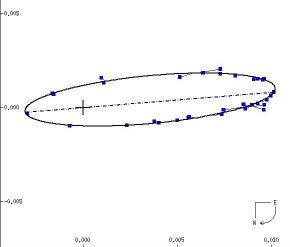
 |
The two class B stars that make Pi Andromedae elliptically orbit nearly in the line of sight every 143.53 days at an average separation of just 1.3 Astronomical Units. (The brighter of the nearly identical pair is placed at the orbital focus; in reality they orbit each other around a common point close to midway between them.) Note the small scale: the tick marks on the axes are just 0.005 seconds of arc apart, making the pair impossible to separate visually through the telescope: the orbit is instead studied spectroscopically and via the interferometer. (From an article by C. A. Hummel et al. in the Astronomical Journal, vol. 110, p. 376, 1995 as given in the Sixth Catalog of Orbits of Visual Binary Stars, W. I. Hartkopf and B. D. Mason, U. S, Naval Observatory.) |